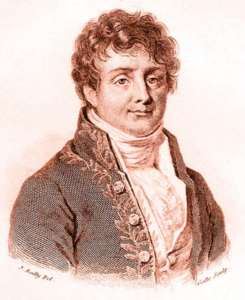March 21 marks the 250th birthday of one of the most influential mathematicians in history. He accompanied Napoleon on his expedition to Egypt, revolutionized science’s understanding of heat transfer, developed the mathematical tools used today to create CT and MRI scan images, and discovered the greenhouse effect.
His name was Joseph Fourier. He wrote of mathematics: “There cannot be a language more universal and more simple, more free from errors and obscurities … Mathematical analysis is as extensive as nature itself, and it defines all perceptible relations.” Fourier’s work continues to shape life today, especially for people like ourselves working in fields such as mathematics and radiology.
Fourier’s life

Mathematician and physicist Joseph Fourier. Wikimedia Commons
As a troubled orphan in France, Fourier was transformed by his first encounter with mathematics. Thanks to a local bishop who recognized his talent, Fourier received an education through Benedictine monks. As a college student, he so loved math that he collected discarded candle stumps so he could continue his studies after others had gone to bed.
As a young man, Fourier was soon swept up by the French Revolution. However, he became disenchanted by its excessive brutality, and his protests landed him in prison for part of 1794. After his release, he was appointed to the faculty of an engineering school. There he proved his genius by substituting for ill colleagues, teaching subjects ranging from physics to classics.
Traveling with Napoleon to Egypt in 1798, Fourier was appointed secretary of the Egyptian Institute, which Napoleon modeled on the Institute of France. When the British fleet stranded the French forces, he organized the manufacture of weapons and munitions to permit the French to continue fighting. Fourier returned to France after the British navy forced the French to surrender. Even in the midst of such difficult circumstances, he managed to publish a number of mathematical papers.
Heat transfer
One of the most important fruits of Fourier’s studies concerns heat.
Fourier’s law states that heat transfers through a material at a rate proportional to both the difference in temperature between different areas and to the area across which the transfer takes place. For example, people who are overheated can cool off quickly by getting to a cool place and exposing as much of their body to it as possible.
Fourier’s work enables scientists to predict the future distribution of heat. Heat is transferred through different materials at different rates. For example, brass has a high thermal conductivity. Air is poorly conductive, which is why it’s frequently used in insulation.
Remarkably, Fourier’s equation applies widely to matter, whether in the form of solid, liquid or gas. It powerfully shaped scientists’ understanding of both electricity and the process of diffusion. It also transformed scientists’ understanding of flow in nature generally – from water’s passage through porous rocks to the movement of blood through capillaries.
Fourier transform and CT
Today, when helping to care for patients, radiologists rely on another mathematical discovery of Fourier’s, now referred to as the “Fourier transform.”
In CT scans, doctors send X-ray beams through a patient from multiple different directions. Some X-rays emerge from the other side, where they can be measured, while others are blocked by structures within the body.

Modern medical imaging machines rely on Fourier’s transform. zlikovec/shutterstock.com
With many such measurements taken at many different angles, it becomes possible to determine the degree to which each tiny block of tissue blocked the beam. For example, bone blocks most of the X-rays, while the lungs block very little. Through a complex series of computations, it’s possible to reconstruct the measurements into two-dimensional images of a patient’s internal anatomy.
Thanks to Fourier and today’s powerful computers, doctors can create almost instantaneous images of the brain, the pulmonary arteries, the appendix and other parts of the body. This in turn makes it possible to confirm or rule out the presence of issues such as blood clots in the pulmonary arteries or inflammation of the appendix. It’s difficult to imagine practicing medicine today without such CT images.
Greenhouse effect
Fourier is generally regarded as the first scientist to notice what we today call the greenhouse effect.
His interest was piqued when he observed that a planet as far away from the sun as Earth should be considerably cooler. He hypothesized that something about the Earth – in particular, its atmosphere – must enable it to trap solar radiation that would otherwise simply radiate back out into space.
Fourier created a model of the Earth involving a box with a glass cover. Over time, the temperature in the box rose above that of the surrounding air, suggesting that the glass continually trapped heat. Because his model resembled a greenhouse in some respects, this phenomenon came to be called the “greenhouse effect.”
Later, scientist John Tyndall discovered that carbon dioxide can play the role of heat trapper.
Life on earth as we know it would not be possible without the greenhouse effect. However, today scientists tend to be more concerned about an excess of greenhouse gases. Mathematical models suggest that as carbon dioxide accumulates, heat may be trapped more quickly, resulting in elevated global average temperatures, melting polar ice caps and rising sea levels.
Fourier’s impact
Fourier received many honors during his lifetime, including election to the French Academy of Science.
Some believed, perhaps speciously, that Fourier’s attraction to heat may have hastened his death. He was known to climb into saunas in multiple layers of clothes, and his acquaintances claimed that he kept his rooms hotter than Hades. At any rate, in May 1830, he died of an aneurysm at the age of 63.
Today, Fourier’s name is inscribed on the Eiffel Tower. But more importantly, it is immortalized in Fourier’s law and the Fourier transform, enduring emblems of his belief that mathematics holds the key to the universe.
For more insights like this, visit our website at www.international-maths-challenge.com.
Credit of the article given to Richard Gunderman, David Gunderman


